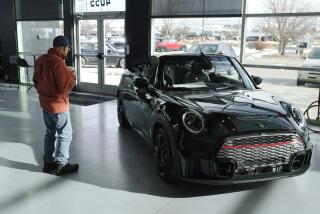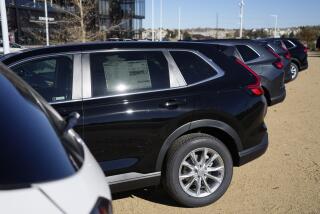Sticker Prices Unlikely to Stick : Cars: Costs of ’92 models rise, but with a sluggish economy and a glut of cars, analysts expect a buyers’ market.
DETROIT — The woebegone auto industry assumed a festive air this week as it began the annual new car parade with old-fashioned hoopla and price hikes.
But analysts say consumers should not be put off: Beyond the hype there are some noteworthy products, and few expect the higher sticker prices to stick because of a sluggish economy and a glut of cars.
With three quarters of red ink behind them and at least one more quarterly loss on the horizon, U.S. auto makers are counting on the new products and spruced-up old ones to lure customers back into dealer showrooms. And the 1.5% to 3.7% increase in 1992 prices over 1991 levels that the Big Three have announced is designed to help mitigate some of their losses.
Japanese auto makers have weathered the recession better than their U.S. competitors, but with new versions of key models such as the Toyota Camry and the Honda Civic expected out this fall, they may use this opportunity to raise prices as well.
But analysts say consumers who have been awaiting the shiny new 1992 models before making their purchase needn’t worry. Auto makers don’t stand much of a chance of capturing that extra revenue.
“The bad news is the increase in sticker price,” said Bob Fitzharris, a consultant with J. D. Power & Associates in Agoura Hills. “The good news is that really doesn’t mean anything.” Nissan Motor, the only Japanese maker to announce 1992 prices so far, said this week it will boost prices by an average of 3.4%, or $450, on its 1992 models. General Motors said 1992 prices will average about 3.1% more than 1991 prices. Ford Motor’s prices are expected to rise about 3.7%, while Chrysler’s are expected to increase 1.5%.
But the recession and glut of new cars produced for the U.S. market--the same combination that has helped auto makers lose $3.2 billion in the first six months of this year--makes the introduction of 1992 cars beginning to appear at dealerships part of a buyer’s market, analysts say.
Some auto makers are already offering discounts, special warranties and low financing rates on the 1992 models, nullifying the sticker price increase before they even hit the showroom floor.
Ford, for example, has sweetened its warranty on most of its 1992 models from one-year/12,000 miles to three years/36,000 miles, and Chrysler is offering 1992 minivan buyers a program that includes a resale value guarantee and the choice between a cellular phone and a $100 U.S. savings bond. This year, auto makers have spent an average of about $1,000 per vehicle on incentive programs, higher than in recent years.
The bottom line is that in a market able to absorb several million fewer cars than can be built, “the stickers don’t really mean a damn thing,” said Chris Cedergren, a marketing analyst with AutoPacific Group in Anaheim. “From a transaction standpoint, there are good deals out there.”
The cars that buyers will be haggling over this fall include new generations of several venerable nameplates.
Among them are seven all-new cars from GM: the Cadillac Seville and Eldorado, Pontiac Grand Am and Bonneville, Buick LeSabre and Skylark and Oldsmobile Eighty-Eight.
There are new versions of Ford’s Econoline and Club Wagon vans, a larger edition of Toyota’s Camry, and new three- and four-door models of the Honda Civic. Also available are a few genuinely new offerings, such as the Mazda MX-3 sports coupe, the Subaru SVX all-wheel drive sports car and two sport wagons from Mitsubishi, the Expo and Expo LRV.
Toyota’s mid-size Lexus ES300 also debuted this week, along with the new Cadillac Seville and Eldorado, and analysts say the crowded luxury segment is shaping up to be especially competitive for 1992. Previously one of the few domestic makers to manage respectable sales in California, Cadillac has seen its market share dwindle as affluent Californians were seduced by the new Japanese luxury lines.
With U.S. sales running 22% below last year’s level for the first seven months of 1991, Cadillac hopes the dramatically restyled models will attract younger luxury car buyers who would otherwise buy a Japanese brand. For those who find the base-price $33,070 Eldorado and $35,575 Seville a little out of their range, analysts say the new, sleeker Pontiac Grand Am, the made-over Ford Taurus and the new Camry are good bets.
And the low-budget 1992 Civic will sport a new Honda engine that has been touted for its ability to achieve higher fuel economy without compromising on power. The Civic will rate 48 miles per gallon in the city and 55 m.p.g. on the highway, except in California, where adjustments for emissions standards will bring its mileage down to 44 m.p.g. in the city and 51 m.p.g. on the highway.
“There is a wide selection of a lot of interesting products, and those products are going to be more efficient, more safe and they’re going to be available at affordable prices,” Cedergren said.
Overall, industry observers say, the 1992 models suggest that the industry’s fascination with high-tech components has plateaued and that there is greater emphasis on improving basic quality.
“From what I see, the auto industry is trying to simplify things in the car,” said Jim Dunne, veteran auto writer for Popular Mechanics magazine. “They’ve loaded cars up with so much new technology, now they’re trying to digest it.”
The exception is safety technology, where competition among auto makers--spurred by federal regulations and consumer demand--has vaulted to higher levels than ever. Nearly 40% of 1992 cars will have driver-side air bags, compared to 30% of 1991 models and 2% of 1988 model cars, according to the Insurance Institute for Highway Safety.
No longer reserved for the more expensive models, driver-side air bags will be standard for the first time on high-volume cars such as the Ford Taurus and Sable. And passenger-side air bags are more prevalent in the 1992 crop as well, with the revamped Pontiac Bonneville representing the first GM car to make the passenger-side bag standard.
Anti-lock brakes, which allow steering in panic stops, will be widely available on GM’s 1992 cars. Chrysler, criticized by Wall Street for its paucity of new products this fall, has cheered safety advocates by making driver-side air bags standard on its 1992 minivans and introducing an optional “integrated child seat” on most of its minivan models.
“What is reflected in the 1992 models is that auto safety is no longer a field driven by the federal register,” said Chuck Hurley, a spokesman for the Insurance Institute. “Now it’s an issue of safety leapfrog, where car companies are scrambling to keep up with public demand for air bags.”
The current consumer-driven auto market, analysts say, is a direct result of Japan’s auto expansion in this country amid a weak U.S. economy. The result has been too many cars, putting customers in the driver’s seat.
But the sovereignty of the consumer in the U.S. auto industry may not last forever. Auto makers are closing plants to ease production overcapacity, and two--Peugeot and Sterling--recently announced that they were giving up in this country. Analysts caution that the shakeout will continue.
“Following a decade that attracted new auto makers to the United States, the 1990s will be the decade when some companies pack their bags and go home,” predicts Mary Ann Keller, an analyst with Furman Selz in New York.
But for now, says J. D. Power’s Fitzharris, “there’s a lot of pressure on the manufacturers, there’s a lot of pressure on the dealers and it’s a great time to buy a car.”
Average Price of a New Car
The domestic auto makers have hiked 1992 prices 1.5% to 3.7% above 1991 prices. Prices for the total industry are expected to be 3% to 5% above what they were in 1991.
Year Domestic Asian* European Total Industry 1988 $13,000 $11,500 $17,000 $13,800 1989 $13,400 $12,600 $23,000 $16,300 1990 $14,500 $14,000 $23,400 $17,300 1991 $13,500 $13,600 $27,000 $18,000
* includes cars built by Japanese auto makers in the United States
Source: J.D. Power & Associates
Average Selling Price of New Car
1984: $11,100
‘85: $11,925
‘86: $12,950
‘87: $13,450
‘88: $14,100
‘89: $15,400
‘90: $15,900
‘91: Preliminary: $16,139
Source: National Automobile Dealers Assn.






